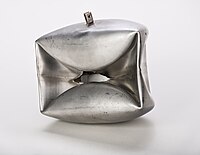
Photo from wikipedia
The vibration characteristics of two piezoelectric cantilevered plates in air and water are investigated in this study. The two-piezoelectric-plate system can provide different vibration characteristics compared to the previous studies… Click to show full abstract
The vibration characteristics of two piezoelectric cantilevered plates in air and water are investigated in this study. The two-piezoelectric-plate system can provide different vibration characteristics compared to the previous studies in which only one cantilever plate is used because the anti-phase motion can be evoked in this newly designed system. First, the vibration characteristics of the plates coupled with a bounded compressible inviscid fluid are derived by theoretical analysis. The governing equation of the piezoelectric plate and the superposition method are used to analyze the vibration displacement of the piezoelectric plate, and the acoustic wave equation is used to derive the fluid equation. The frequency eigenfunction of the coupled system is derived by the boundary conditions of hydrostatic equilibrium. After solving the characteristics equation, the resonant frequencies and corresponding mode shapes for assumptions about both compressible and incompressible fluids and the velocity and pressure fields of the fluid can be obtained. Next, finite element analysis (FEA) is used to verify the theoretical results. It is shown from this study that the theoretical predictions of resonant frequencies and the corresponding mode shapes have a good agreement with those of the FEA for water and compressible fluid assumption of air. The unique high pressure value in the outer or middle layer in an air-coupled condition does not occur in water because water’s compressibility is relatively smaller than that of air. The influence of the depth and properties of the fluid on the behavior of the coupled solid–fluid is also investigated. For anti-phase motion, the frequency variation with change in the depth of the middle layer is similar to that of the outer layer for both air- and water-coupled conditions. For in-phase motion, the variation in frequency with the change in the depth of the middle layer is negligible. The particular modes in fluid compounded by modes in vacuum are analyzed on the distortion of mode shapes at higher resonant modes. These results can provide complete information on the vibration characteristics of a solid–fluid coupled system and will contribute to the evolution of hydroacoustic devices in which two piezoelectric plates are used.
Journal Title: Archive of Applied Mechanics
Year Published: 2020
Link to full text (if available)
Share on Social Media: Sign Up to like & get
recommendations!